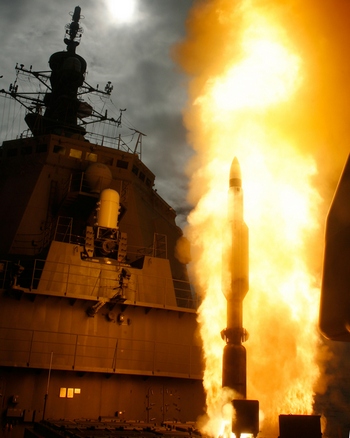US Navy Aegis cruisers will attempt to shoot down a disabled spy satellite before it reenters the Earth's atmosphere in late February, to avoid the potential danger posed by its hazardous hydrazine rocket fuel.
It will be the first time the USA has tried to shoot down a satellite since September 1985, when a US Air Force Boeing F-15 launched an experimental anti-satellite missile that intercepted and destroyed an obsolete spacecraft.
The US government strongly criticised a Chinese anti-satellite test in 2007, which used a ground-launched interceptor, arguing the test resulted in a massive cloud of orbital debris that posed a danger to civilian spacecraft.

Standard SM-3 launch © US Navy
The Department of Defense says the "uncontrollable US experimental satellite" was launched in December 2006 and is expected to reenter the atmposphere between the end of February and early March.
Because the 5,000lb (2,250kg) imaging spacecraft lost power after launch, before it could use any of its thruster fuel, the DoD estimates that more than half its mass will survive reentry, including the tank containing 1,000lb of highly toxic hydrazine propellant.
"Although the chances of an impact in a populated area are small, the potential consequences would be of enough concern to consider mitigating actions," says the Pentagon.
The US Navy has temporarily modified three Aegis cruisers and three Raytheon Standard SM-3 surface-to-air missiles in the hope of getting two shots at the crippled satellite before it reenters. The DoD says it has "high confidence" the engagement will be successful.
"We will determine the optimal time, location and geometry for a successful engagement based on a number of factors," says the Pentagon. A seven- to eight-day window for the engagement opens after NASA's Space Shuttle Atlantis returns from space on 20 February.
The Navy wants to intercept the missile at a point just above the atmosphere where it will maximise likelihood of bringing the spacecraft down in an unpopulated area. The intent is to rupture the 20in-radius hydrazine tank.
From positions in the northern Pacific, the ships will attempt to intercept the satellite at 130nm altitude to reduce the risk of debris in space. If the satellite is hit, the DoD hopes half the debris will reenter in the first two orbits and the rest soon after.
The Standard SM-3 is part of the US Navy's Aegis ballistic missile defence system, which has scored 12 intercepts in 14 attempts against missile targets. The missile is equipped with an infrared-guided kinetic warhead. Not details of the modifications have been released.
Source: FlightGlobal.com























